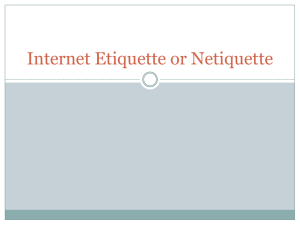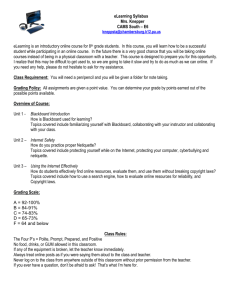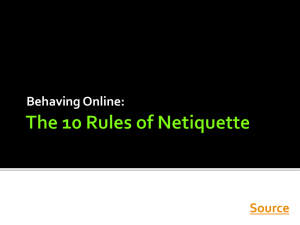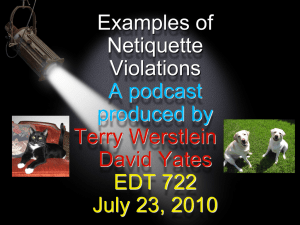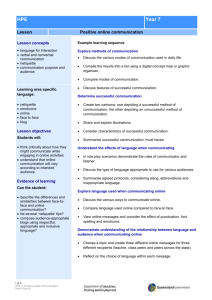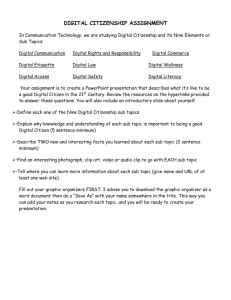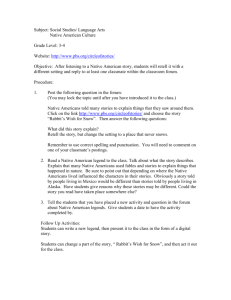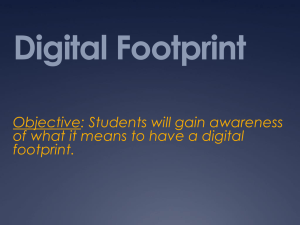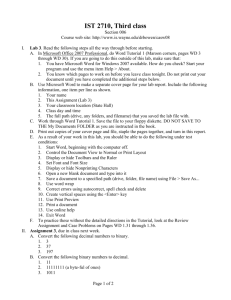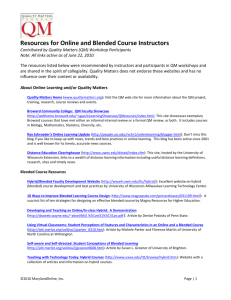Netiquette- complete lesson
advertisement
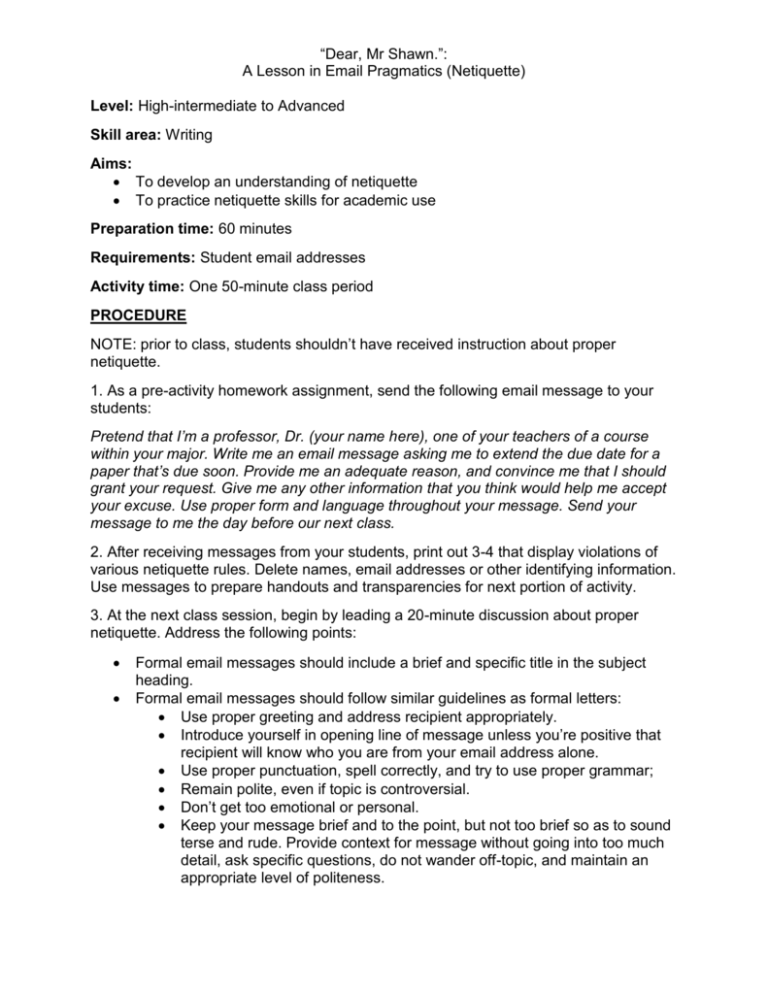
“Dear, Mr Shawn.”: A Lesson in Email Pragmatics (Netiquette) Level: High-intermediate to Advanced Skill area: Writing Aims: To develop an understanding of netiquette To practice netiquette skills for academic use Preparation time: 60 minutes Requirements: Student email addresses Activity time: One 50-minute class period PROCEDURE NOTE: prior to class, students shouldn’t have received instruction about proper netiquette. 1. As a pre-activity homework assignment, send the following email message to your students: Pretend that I’m a professor, Dr. (your name here), one of your teachers of a course within your major. Write me an email message asking me to extend the due date for a paper that’s due soon. Provide me an adequate reason, and convince me that I should grant your request. Give me any other information that you think would help me accept your excuse. Use proper form and language throughout your message. Send your message to me the day before our next class. 2. After receiving messages from your students, print out 3-4 that display violations of various netiquette rules. Delete names, email addresses or other identifying information. Use messages to prepare handouts and transparencies for next portion of activity. 3. At the next class session, begin by leading a 20-minute discussion about proper netiquette. Address the following points: Formal email messages should include a brief and specific title in the subject heading. Formal email messages should follow similar guidelines as formal letters: Use proper greeting and address recipient appropriately. Introduce yourself in opening line of message unless you’re positive that recipient will know who you are from your email address alone. Use proper punctuation, spell correctly, and try to use proper grammar; Remain polite, even if topic is controversial. Don’t get too emotional or personal. Keep your message brief and to the point, but not too brief so as to sound terse and rude. Provide context for message without going into too much detail, ask specific questions, do not wander off-topic, and maintain an appropriate level of politeness. Ask for reply at recipient’s convenience, keeping in mind some people may not check their email accounts frequently and may have other responsibilities. End your message with a proper closing that includes your name and affiliation. When responding to an email, don’t reply to original recipient list unless it is necessary. Most times, reply only to original sender, especially if message is private. When responding to an email, don’t include original message in your reply unless it’s very brief and it’s necessary to help clarify your message. Never forward or send chain letters or advertisements in academic or professional email messages. 4. For the next portion of the activity, divide students into groups of 2-3, give each group activity handout, and ask them to analyze messages and discuss for approximately 15 minutes netiquette errors found in each one. 5. Afterwards, use transparencies of messages to discuss as a whole class for remainder of the period the netiquette errors found in each example. Project one message at a time on screen and ask students to identify netiquette errors. When students identify an error, highlight it on transparency. If students identify a portion of the message as an error that is actually correct, explain why it’s not an error. If students don’t identify an error, then point out error to them on transparency. When all errors in a message have been identified, discuss ways to correct errors. Write corrections on transparency. 6. For homework, ask students to correct and rewrite their original requests and email them to you again. Send replies to them informing them whether or not you would accept their request based on their use of netiquette. Variation: This activity can be conducted without computers, in class over a two-day period. Step 1 can be done in class as a writing assignment before beginning the netiquette activity. This may be necessary in situations where computers are scarce. If this is the case, allot 20 minutes to the writing assignment. Afterwards, collect the writing assignment and complete Step 3 of the activity. Extend this step to 30 minutes by devoting time to small-group analysis of the model email. That should conclude the class period. Before the next class period, complete Step 2 of the activity. At the beginning of the next class period, devote 15 minutes to reports of the small-group analyses. Then complete Steps 4, 5 and 6 of the activity. Conclusion: As email becomes the dominant form of communication in academia, teachers must devote more attention to pragmatic skills necessary to communicate effectively in this genre. Through an assignment such as this netiquette activity, students are exposed to issues involved in formal email communication and can develop their skills in the safe environment of the classroom. Netiquette Handout Netiquette: “What is Netiquette? Simply stated, it's network etiquette -- that is, the etiquette of cyberspace. And "etiquette" means "the forms required by good breeding or prescribed by authority to be required in social or official life." In other words, Netiquette is a set of rules for behaving properly online. “When you enter any new culture -- and cyberspace has its own culture -- you're liable to commit a few social blunders. You might offend people without meaning to. Or you might misunderstand what others say and take offense when it's not intended. To make matters worse, something about cyberspace makes it easy to forget that you're interacting with other real people -- not just ASCII characters on a screen, but live human characters. “So, partly as a result of forgetting that people online are still real, and partly because they don't know the conventions, well-meaning cybernauts, especially new ones, make all kinds of mistakes.” (Shea, 1994). Basic Guidelines for Proper Email Netiquette: Formal email messages should include a brief and specific title in the subject heading. Formal email messages should follow similar guidelines as formal letters: Use proper greeting and address recipient appropriately; Introduce yourself in opening line of message unless you’re positive that recipient will know who you are from your email address alone; Use proper punctuation, spell correctly, and try to use proper grammar; Remain polite, even if topic is controversial; Don’t get too emotional or personal; Keep your message brief and to the point, but not too brief so as to sound terse and rude. Provide context for message without going into too much detail, ask specific questions, do not wander off-topic, and maintain an appropriate level of politeness; Ask for reply at recipient’s convenience, keeping in mind some people may not check their email accounts frequently and may have other responsibilities; End your message with a proper closing that includes your name and affiliation. When responding to an email, don’t reply to original recipient list unless it is necessary. Most times, reply only to original sender, especially if message is private. When responding to an email, don’t include original message in your reply unless it’s very brief and it’s necessary to help clarify your message. Never forward or send chain letters or advertisements in academic or professional email messages. The following message is an example of an actual student email to demonstrate acceptable format. Use this as an example of how to structure your formal messages. Dear Professor Ford, (proper greeting and address) This is Xxxx Xxx, one student from your ELI 100 class. (proper introduction) I do not think I can turn the report that is due next Monday. (context provided) I have been working it but I do not think I can finish on time. (appropriate details) So, I liked to ask you to delay me the time to turn the paper. (specific request) I will tell you more about my excuses for it when I come to class. (politeness) Please consider my asking, and reply to me when you have time. (politeness) Thank you, (proper closing) Xxxx Xxx (signature provided) Here are some examples of improper uses of Netiquette in email messages: ----------------------------------------------------------------------------------------------------------Hello Professor~ I don't think, I can turn the reports on next monday. I liked to delay the time to turn the paper. Can you do it for me? I have some reasons and excuses for it. I will talk to you about it in class. so, please delay the due date for me. Plz also reply me for its answer on e-mail. Thank you. ----------------------------------------------------------------------------------------------------------Proffessor Ford, Hi. This is XXXXX from xxx 100 calss. I'm writing this email about the paper due on next Monday. I need to do more reserach.B!!So I think I need more time to do my research to complete my paper. I will turn it in on next Wednesday. Thank you. XXXXXXX ----------------------------------------------------------------------------------------------------------Professor Ford: I am writing to ask you to extend the deadline date of the paper in your class. I am making every effort to meet the deadline. However, I have not gotten the books which I ordered yet.Now I am looking for other resources. So you can expect my paper within 7 days. I would appreciate your patience. Thank you very much for your consideration. Sincerely yours, XXXXXXX ----------------------------------------------------------------------------------------------------------- Good morning, Professor Ford, This Is XXXXX who is in your xxxxxxxx 400 class. According to the research paper which is due on next Monday, i have some difficulties to say. First of all, you want us to interview one family which has special need kid in it, you just gave me one week to do the interview and you want us to find the familiy ourselves. The time is not enough and I think i need to interview Mr. and Mrs. Johnes one more time, so I need some time to work on the interview to get more information about my research paper. And second, you want us to turn in research paper which has 15 pages. It is a kind of hard for us to do the research paper on the first time and turn in so many pages. I understand very well that you want us to learn more from this research paper. But it seems an impossible mission for me. I think that not only for me, some of my classmates also feel this way that the research paper is too strict and hard for us. I hope you can think about my suggestion and give us more days to work on our research paper. Thank you a lot. Best regards, XXXXXXX 11,16 ----------------------------------------------------------------------------------------------------------Student’s name Student’s email address November 16, 2001 Dr. Ford Department of Pshychology Dear Dr. Ford, For the paper assigned in PSY301 class, I have a will to ask you for an extension of the date to turn it in. There is not enough time to complete the paper by that time for everybody in that class. I really appreciate your concern. Sincerely, XXXXX Here are some Internet references for Netiquette: Hambridge, S. (1995). RFC 1855: Netiquette Guidelines. Internet document, available on the World Wide Web at < http://www.stanton.dtcc.edu/stanton/cs/rfc1855.html>. Rinaldi, A.H. (1998). The Net: User Guidelines and Netiquette. Internet document, available on the World Wide Web at <http://www.fau.edu/netiquette/net/>. Shea, V. (1994). Netiquette. The Internet: Albion Books. Online edition available on the World Wide Web at <http://www.albion.com/netiquette/book/index.html>.
